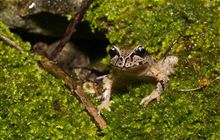Spot-a-skink
Archived content: This media release was accurate on the date of publication.
Date: 27 November 2017
The Department of Conservation (DOC) wants Manawatu residents to lend a hand and report local lizard sightings.
Sue Moore, Senior Ranger Biodiversity for DOC Manawatu says reports of skink and gecko sightings from the public are important to help build an accurate picture of gecko and skink distribution in the region.
"We just updated the national herpetofauna database (an atlas of amphibians and reptiles) with recently reported sightings, but there are not many records from the Manawatu."
"Hopefully, this is because Manawatu residents are not aware that they should report lizard sightings, rather than a reflection of low local lizard populations – we need your data to be sure."
New Zealand has more than 109 lizards (geckos and skinks). All of our lizards are endemic, which means they are found nowhere else in the world.
Species usually reported in the Lower North Island include northern grass skink, glossy brown skink, copper skink, spotted skink, ornate skink, Raukawa gecko, southern North Island forest gecko, and Ngahere gecko.
Lizards can be quite tricky to identify, Sue explains. "Details like scale numbers, pattern, colour, and scale arrangement are used to identify lizard species. Subtle differences are important, so good quality photos are really useful when reporting lizard sightings."
Recently, we’ve had several sightings of ornate skinks around Palmerston North. Ornate skinks have a distinctive tear drop marking under their eye, making them easy to distinguish from other species.
"Unfortunately, you are quite likely to spot a plague skink around Palmerston North," says Sue.
Plague skinks, sometimes known as rainbow skinks, are a pest introduced from Australia that threaten our rare native species.
Plague skinks breed prolifically and compete with our native lizards for food, habitat and space. They thrive in most conditions, and are commonly found in gardens, urban centres, commercial areas, industrial sites, garden centres, waste ground, and even shipping containers!
Reported sightings of plague skinks will help us to assess and manage the threat to native lizards, so information from the public is a huge help.
"We know plague skinks are in Palmerston North but we don’t know how far they have spread," says Sue. "We are especially concerned about coastal areas, where they may find their way onto boats and spread to our offshore islands".
To report gecko and skink sightings:
- email details and photographs to manawatu@doc.govt.nz,
- fill out an Amphibian and Reptile Distribution Scheme Card (ARDS card).
Sightings can be reported any time, but you are most likely to see lizards in the warmer months (spring, summer, and autumn).
You can also help in your own backyard by creating lizard friendly spaced in your garden where they have cover from predators and a continuous supply of food. See Attract lizards to your garden.
Background information
You can help stop the spread of plague skinks.
- If you have found them on your property, tell neighbours and friends.
- If you are moving to an area that is free of plague skinks, check your belongings thoroughly first.
- Potting mix in potted plants is a favoured breeding habitat; check them for small white eggs.
Find more information on:
- New Zealand’s lizards
- Lizard identification:
- Plague skinks
Contact
Kelly Hancock, Ranger Community
Email khancock@doc.govt.nz




